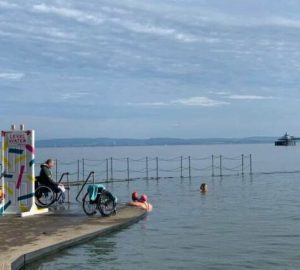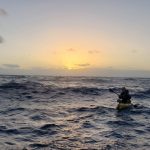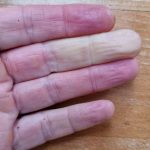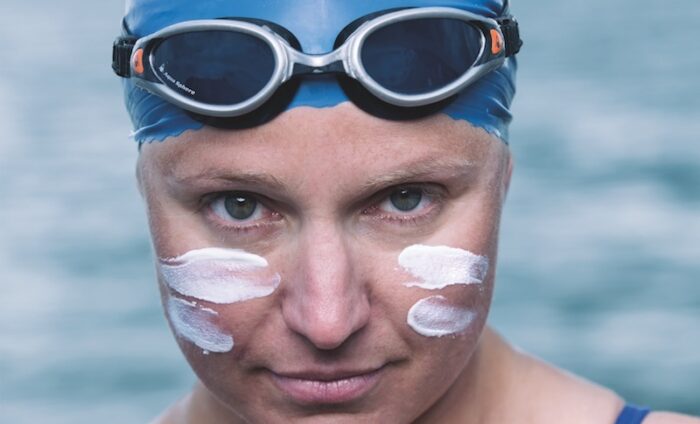
Sarah Thomas and her historic 4-way crossing of the English Channel
In the early hours of Sunday 15 September 2019, Sarah Thomas set off on an unprecedented four-way English Channel swim. 54 hours and 10 minutes later she swam into Shakespeare Beach to make marathon swimming history. Elaine K Howley was onboard Anastasia as a member of Sarah’s support crew. This is the story of her friend’s unfathomable English Channel feat.
In the earliest minutes of 16 September 2019, Sarah Thomas, a 37-year-old healthcare recruiter from Conifer, Colorado, couldn’t see what lay ahead of her. Nevertheless, she knew she was close to an important juncture in her attempt at swimming the English Channel four times nonstop.
Some 24 hours earlier, she had left the beach at Samphire Hoe and swum to Cap Gris Nez in France, and now she was nearly back to Samphire Hoe. She could all but feel the rocks beneath her feet as she anticipated walking out of the sea and onto the shingle beach at the base of Dover’s White Cliffs.
But there was a problem with this plan. Good weather had attracted a half dozen aspiring Channel swimmers and their pilots to Samphire Hoe’s beach to launch their own cross-Channel swims. They bobbed and jostled in the dark, as one-by-one the swimmers waded into the water and began swimming.
There simply wasn’t enough room to maneuver around those other vessels and safely land Thomas on the beach.
So Thomas’ pilot, Eddie Spelling aboard Anastasia, wisely guided her a few hundred yards to the northwest – smack into the centre of a massive concrete seawall. There would be no beach landing for Thomas this time.
As the turn approached, I got into the inflatable rescue boat towed behind the main support boat with Mike Spelling, one of the boat crew, and we motored up alongside Thomas to help guide her into the turn. When she was just 100 metres or so away from the wall, I slipped over the edge of the boat into the water. I’d donned large flippers to help me keep up with Thomas’ speedy stroke and carried a drawstring bag full of lanolin, snacks and a bottle full of warm water. Now officially dubbed a “safety swimmer,” I freestyled alongside and slightly behind Thomas. A few metres shy of the wall, she picked her head up and cried out for the beach.
The bearer of bad news, I explained that the landing would be here, at Samphire Hoe’s massive concrete seawall, rather than at the shingle beach.
Thomas stuttered a second as the realisation sunk in – just as with the first turn in France, she wouldn’t be clearing the water at this second turn. “I’m devastated,” she said. The anguish in her voice broke my heart and all I wanted to do was to hug her and tell her it was going to be ok. But if she was going to continue on in her quest to swim the English Channel four ways, official rules meant I couldn’t so much as pat her hand. She sighed heavily as she treaded water and gulped down some baby food. She promptly vomited again, as she had been doing for some time on the swim back from France, and said “I’m really not sure I have this in me.”
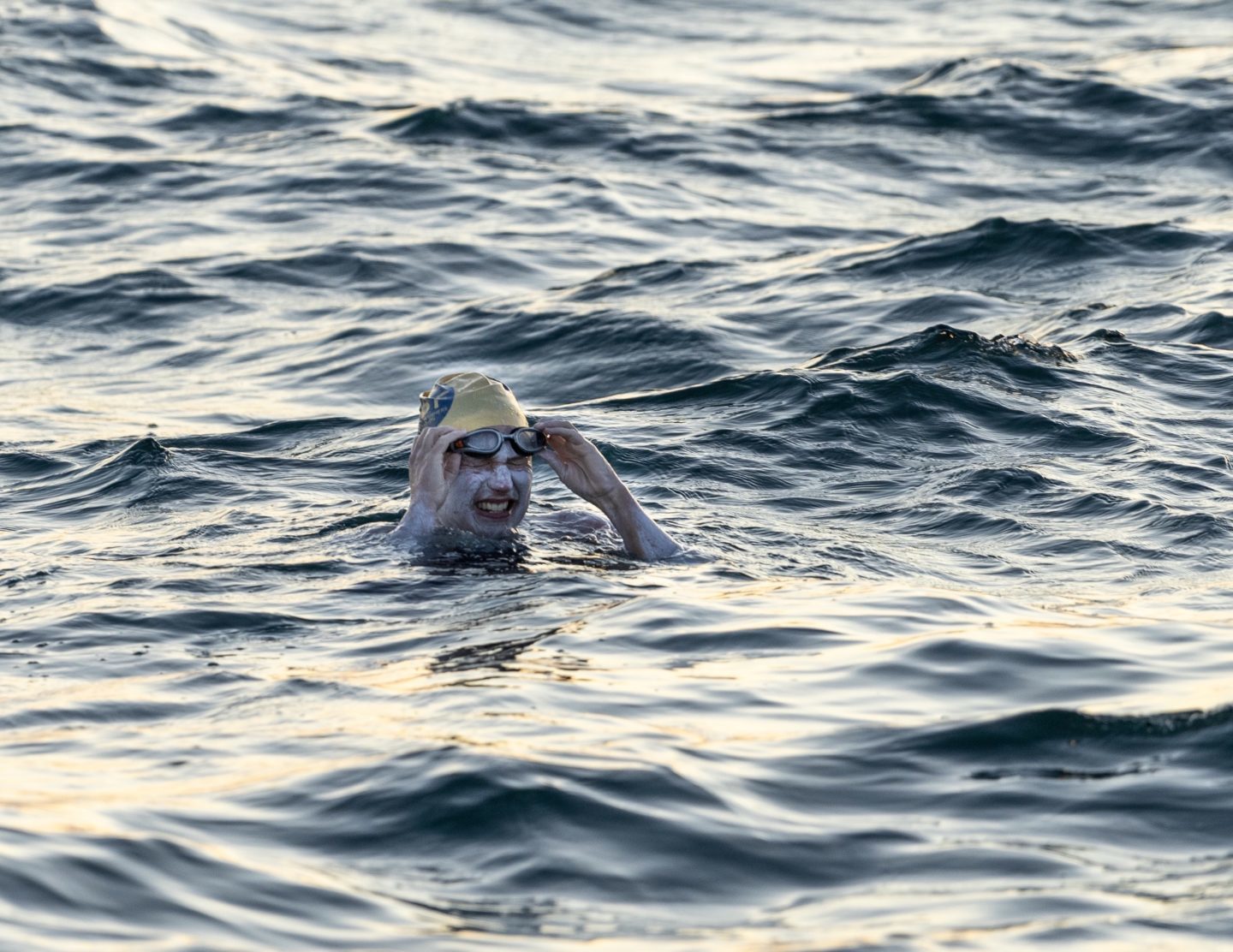
Credit: Jon Washer
Without hesitation I replied, “yes, you do,” and I meant it. I knew how hard she’d worked to be ready for this moment. I also knew that night-time is difficult during any swim, especially when you’re knee-deep into your second night at sea. “Just hang in there until sunrise,” I pleaded. “Everything will look better in the sunlight.” Thomas’ expression read weary and frustrated, but she understood what I was asking.
She handed me the water bottle and reluctantly began swimming again. Once I was back on the boat, we adjusted her feeds to remove the apple juice that was making her vomit, and we shortened the interval between feeds to try to get more calories into her to top up what she’d lost. Before long, she had settled back into her practised rhythm and, stroke by stroke, she pulled herself toward sunrise. By the time the sun was fully up, she felt like a different person, both mentally and physically.
A few hours and some magnificent piloting later, Thomas landed right on the tip of Cap Gris Nez, a precarious and rocky point that juts out from the French mainland. The narrowest point of the Channel, the Cap is the place swimmers want to finish. But it’s difficult to stick the landing as strong currents and tides push enormous amounts of water around that point. The faster successful swimmers have a higher likelihood of landing there, while slower swimmers are usually pushed north towards Wissant Beach, which adds a couple extra miles and hours to a crossing – neither of which is ideal when contemplating multiple laps across the Channel.
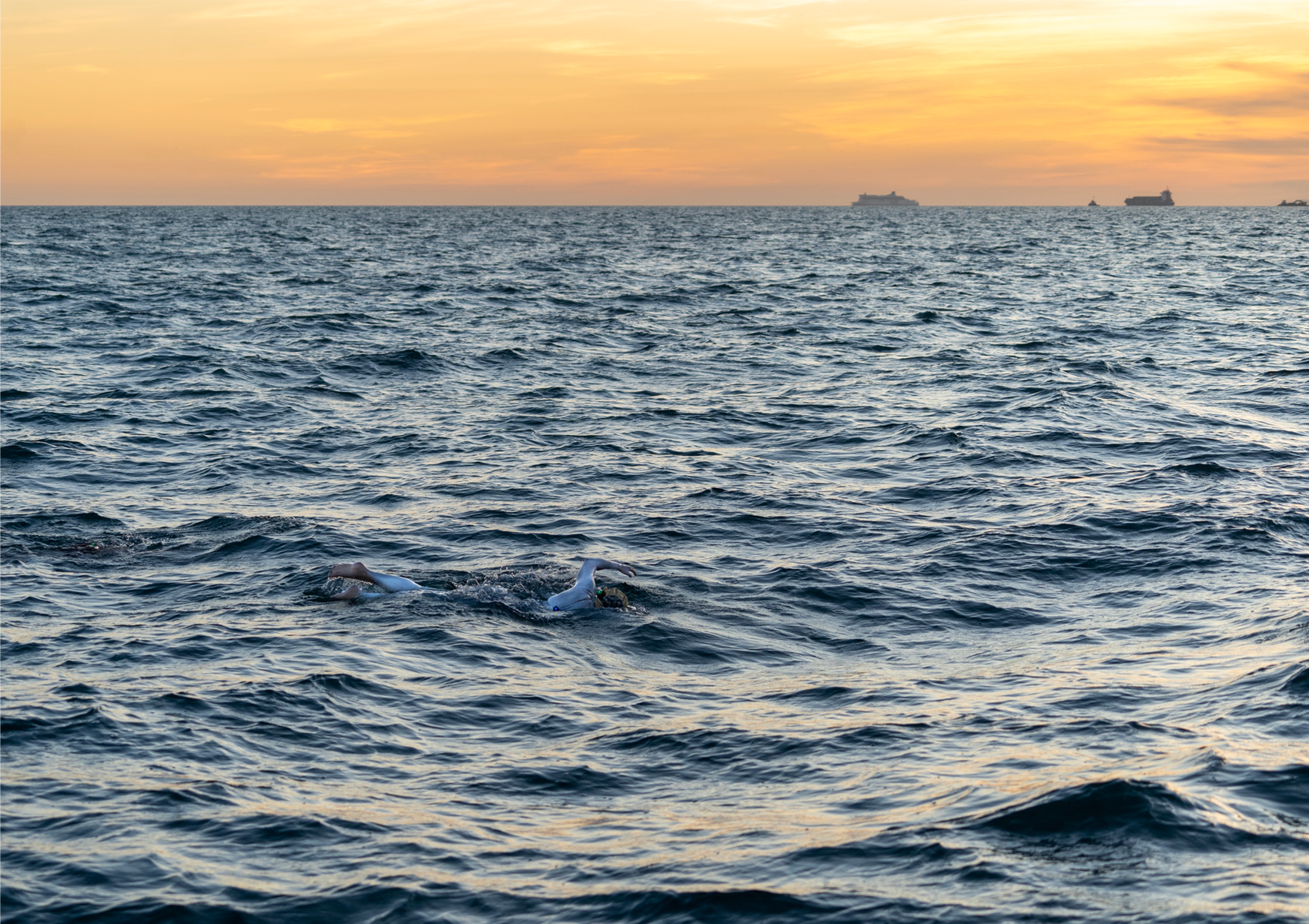
Credit: Jon Washer
As she closed in on the Cap for the second time in two days, I again jumped in as she prepared to make an unprecedented third turn into a fourth lap of the English Channel. Thomas was in much better spirits this time as I swam up for a visit with my drawstring bag full of goodies. She’d just become only the fifth person in history to complete a triple crossing of the English Channel – a monstrous success that any ultramarathon swimmer would be thrilled to claim.
For Thomas, however, the limit of potential lies beyond the edge of credulity for most of the rest of us mere mortals. As she shoveled handfuls of warm oatmeal into her mouth and reapplied lanolin, she groaned and said, “Ugh. Now I’ve got to swim all the way back.” Resigned to her fate of crossing the Channel one more time, she slithered back into the sea and launched herself into uncharted territory.
The backstory
A competitive swimmer as a child and through high school and college, Thomas spent much of her life following the black line at the bottom of the pool. She’d not done much open water swimming, but on a friend’s suggestion she swam a 10K race in the Horsetooth Reservoir in Fort Collins, Colorado in 2007. “It’s like that 10K distance was an awakening. That’s where I belonged,” she says.
From that 10K race, she began dreaming bigger. She progressively took on larger challenges, and successfully crossed the English Channel as a solo swimmer in 2012. A 44-mile double crossing of high-altitude Lake Tahoe and a 50-mile double crossing of Lake Memphremagog in Vermont and southern Quebec, both in 2013, showed she had unequalled talent in completing extraordinarily long swims. An 80-mile record-setting swim across Lake Powell in Utah and Arizona in 2016, and a 104.6-mile world record longest solo unassisted marathon swim in Lake Champlain in Vermont and New York in August 2017 further elevated her superhuman swimmer profile.
Thomas was still riding a high from finishing that Lake Champlain swim when, two months later, she found a lump in her breast. Hoping it was just a cyst, she willed it to go away, but it didn’t. She visited the doctor, and before long, she had a diagnosis of Stage 2 triple negative breast cancer, an aggressive form of the disease.
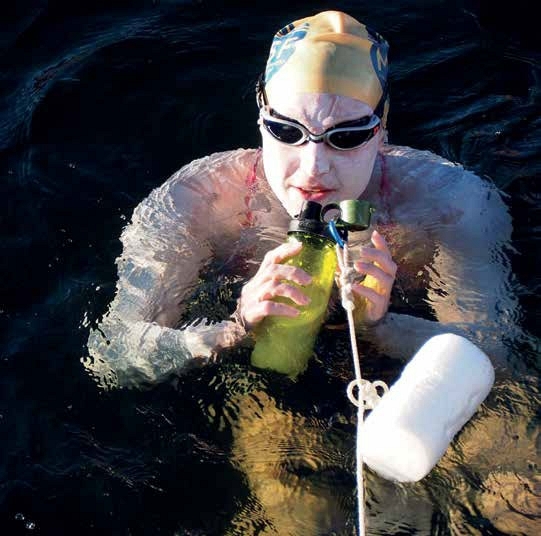
Sarah feeding on her 80- mile swim across Lake Powell
Credit: Ken Classen
Swimming through treatment
From November 2017 through August 2018, Thomas endured a series of painful therapies to treat the cancer. She started 16 rounds of chemotherapy infusions that caused her to lose her hair. These were followed by surgery to remove and reconstruct her right breast. Soon after she’d recovered from that, she started radiation treatments, 25 in total, which burned the skin on her chest and under her arm. “The radiation was the worst part,” she says.
Through all of it, she swam as much as her doctors and battered body would allow; in typical Thomas fashion, she had refused to postpone the date of her English Channel quad attempt. It turned out to be a wise decision, and Thomas credits swimming with helping her survive her ordeal with cancer. Knowing that she had the biggest swim of her life already booked helped focus her energy and provided structure. Fitting swimming in around her full-time work and schedule of doctor’s appointments and treatments wasn’t easy, but Thomas made it happen. Concentrating on her impending attempt at making history gave her a purpose.
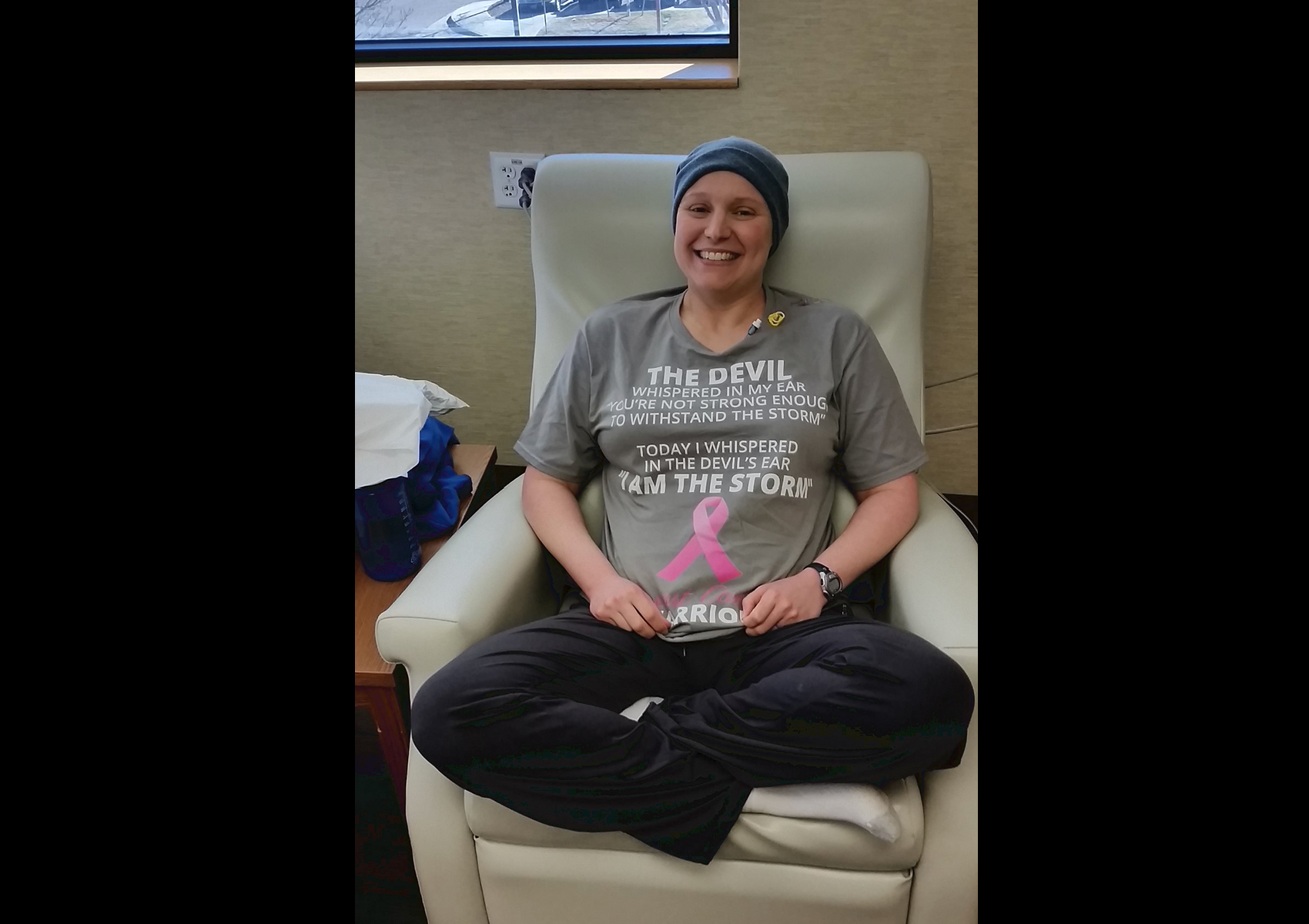
From November 2017 through August 2018 Sarah underwent 16 rounds of chemotherapy and 25 radiation treatments.
Thomas was discharged from active treatment for breast cancer in August 2018. Just two weeks later, she completed the Horsetooth Reservoir 10K, the annual event that first hooked her on open water swimming. She was slower than usual and exhausted for days afterwards, but the joy of being able to “plod down the lake, with [husband] Ryan by my side in a kayak,” was an affirmation that cancer may have taken a lot of things from her, but not her identity as a marathon swimmer.
From that moment onward, she was in training mode, and she had a daunting task ahead to build herself back up to the level that a quadruple crossing of the English Channel would require. At first, she felt slow and heavy in the water, but with powerful motivation and consistent training, she grew stronger and rebuilt her stamina.
Finally, at seven minutes past midnight on 15 September 2019, she arrived at the pebble beach at Samphire Hoe ready to prove that cancer wouldn’t define her.
The fourth lap
After leaving the Cap for the second time Thomas says she felt confident that she would manage to finish it. Indeed, she and her crew were prepared for that crossing to be the least dicey of the four.
But tides and currents don’t always do what they’re supposed to do, and several hours into her final crossing, the tide turned early. She wasn’t in the right place to ride it home. Meanwhile, the breeze had picked up, and the water grew lumpy. Suddenly, Thomas found herself fighting for every inch.
Aboard the Anastasia, we grew concerned. After all she’d been through in the past year and over the previous 40-odd hours, how could she even still be awake, let alone churning her arms over at the rate needed to outrace the tide? We took turns support swimming for her on a strict schedule dictated by the rules laid out by the Channel Swimming & Piloting Federation, the organising body overseeing the swim.
We worked hard to keep her spirits up as she fought her way out of the shipping lane and into inshore waters. It was excruciating, but she did it.
Then came the fun game of guessing when and where she would land. By this time, the news media had gotten wind of the utterly astounding event taking place just offshore and began calling me for updates. Where will she land? Can we get a photographer in place? Will she be able to do interviews when she lands?
The answer to all of these questions was a resounding: “I don’t know.” Those who know Channel swimming understand that there are zero certainties in the sport, but journalists racing for a scoop on deadline don’t always get that.
We were aiming for Shakespeare Beach, but the tide, again changing a bit earlier than expected, began sweeping her towards St Margaret’s Bay. It seems there was likely a cavalcade of reporters and well-wishers driving to and fro between the two locations in an effort to get on shore at the right place for when Thomas finally made landfall.
But she still had the hardest hour yet to come – that very last hour. As the tide moved us toward the ferry terminal – not a desirable place to land an exhausted swimmer – pilot Eddie Spelling made a critical decision to turn Thomas sharply into shore, aiming again for Shakespeare Beach.
Thomas had to crab across the swiftly moving water. She could feel it ripping and looking up, she saw every member of her crew watching over her and clapping, cheering loudly to just, “Go, go, go!” From her mother, Becky Baxer, who screamed herself hoarse, and her husband Ryan Willis, who paced back and forth while preparing feeds, and fellow marathon swimmer Craig Lenning who kept up a steady clap and cheering when he wasn’t support swimming, we all willed her forward – wishing with every stroke that we could make this last stretch just a little bit easier, but knowing full well Thomas had to finish this herself.
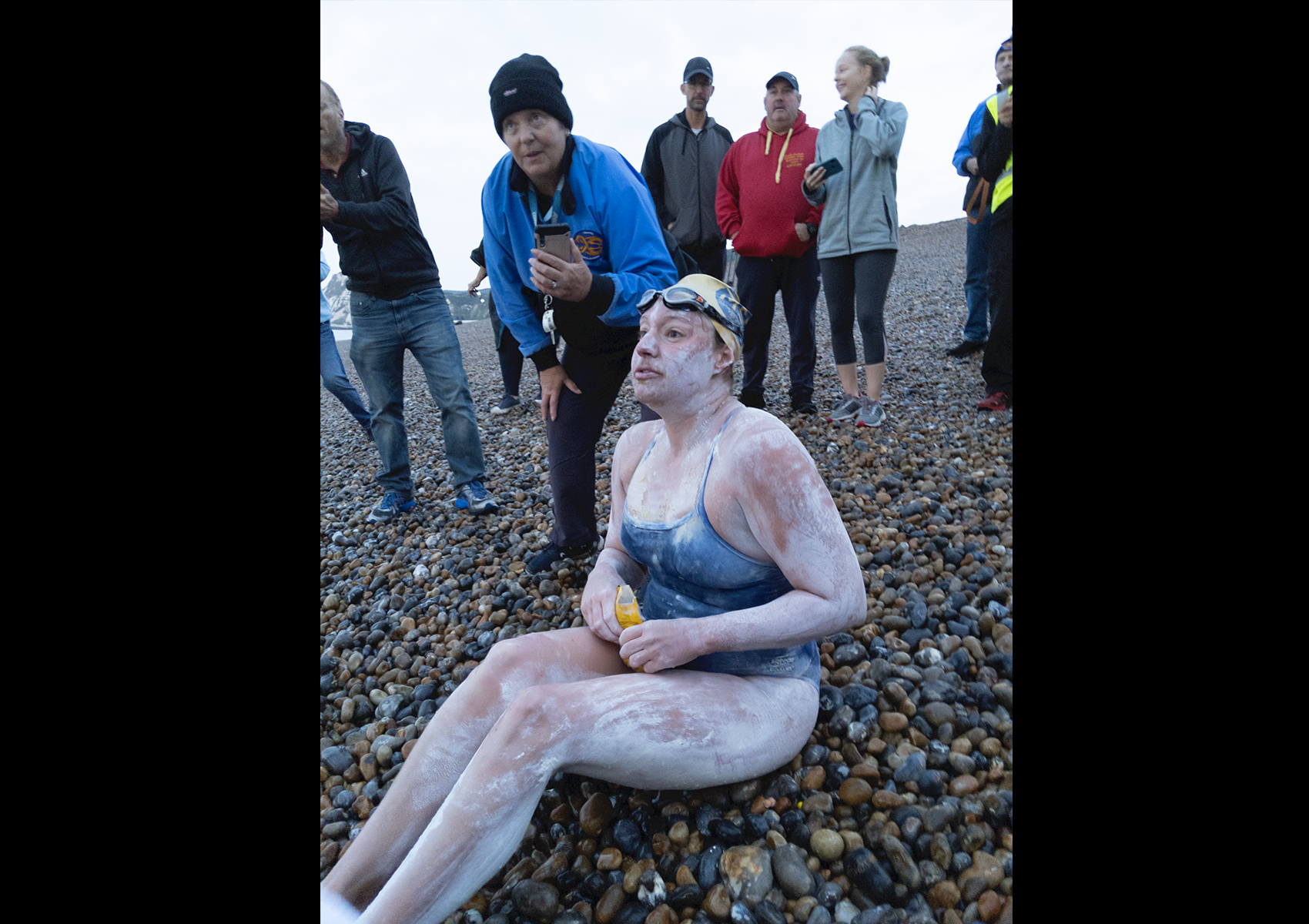
Sarah in her now iconic pose on Shakespeare Beach
Credit: Jon Washer
Karl Kingery, another marathon swimmer on the crew, jumped in to support swim with her in that final hour, and his quick pace helped give Thomas a boost. Dawn began to break as she closed in on Shakespeare Beach. The plan was to have me and Karl act as safety swimmers to follow her into the beach at the landing – both to help with crowd control if needed and to assist her in getting back to the support boat after the swim ended. I hopped in – this time without my flippers or the bag of grease, but with a heart bursting with pride and relief for my friend. Her journey to the other side had nearly come to a close. All that lay between her and history was 200 metres of shallow water.
By now you’ve no doubt seen the video footage of Thomas’ extraordinary stumble and crawl up the beach, and the iconic photo of her sitting on the stones looking stunned and puffy while sipping champagne from a glass handed to her by an enthusiastic fan. A package of M&Ms clutched in her other hand and slathered with the remnants of nappy rash ointment – what had managed to cling to her skin for the 54 hours and 10 minutes she was submerged – she is a vision of Channel royalty, radiant in her success and at peace with herself and her body. Cancer may have changed her physical being, but it could not dominate her spirit. She had survived, in every sense of the word.
Ever humble when asked how she felt at finishing, Thomas replied, “I really can’t believe we did it.” For our part as crew members and family, we never once wavered in our belief that she could – or that she would.
Survivor
Sarah Thomas dedicated her swim to: “all the survivors out there. This is for those of us who have prayed for our lives, who have wondered with despair about what comes next, and have battled through pain and fear to overcome. This is for those of you just starting your cancer journey and those of you who are thriving with cancer kicked firmly into the past, and for everyone in between. This is for our family and friends who held us in their arms and provided the strength and support we needed in the hardest times. This is for those who struggled alongside us, feeling our pain as if it was their own. I’m holding you all in my heart and swimming for our health and futures. We are stronger together, each and every one of us.”
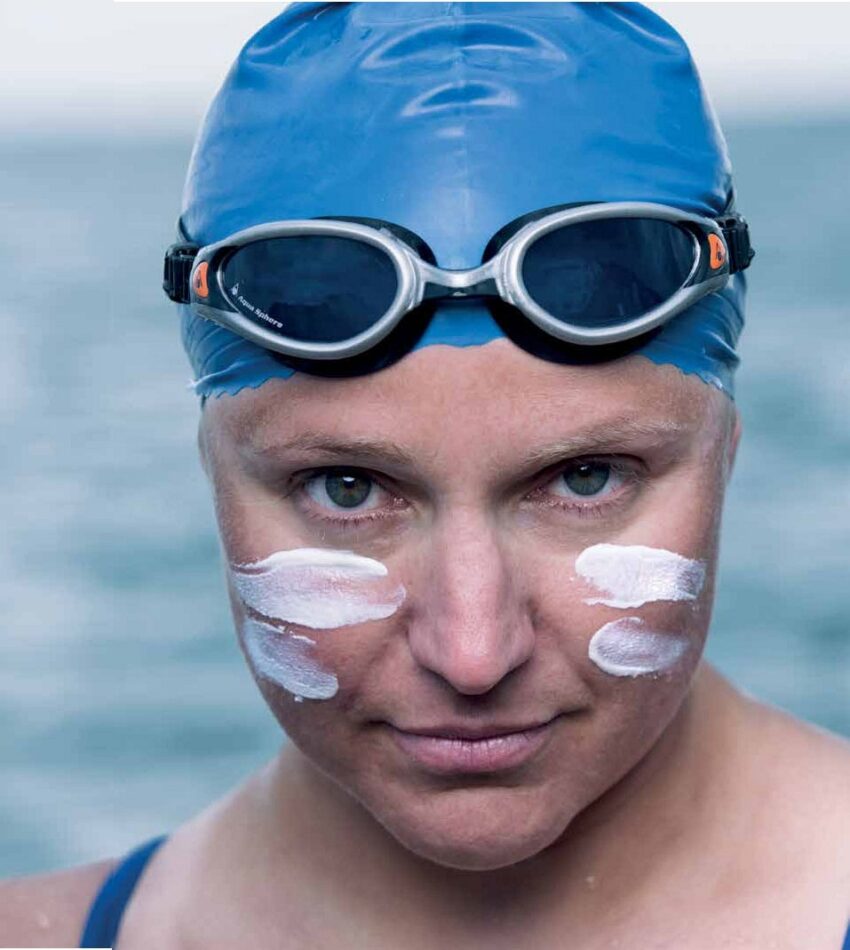
Credit: James Mussselwhite





